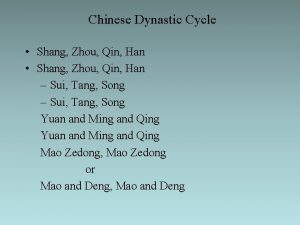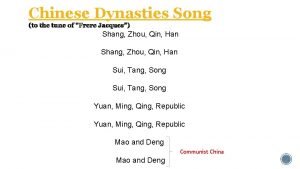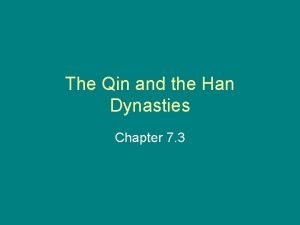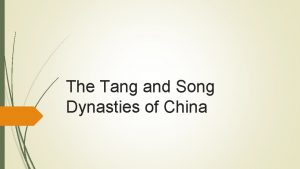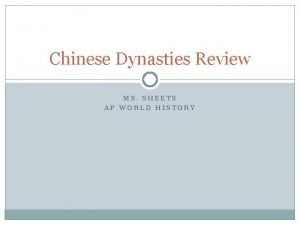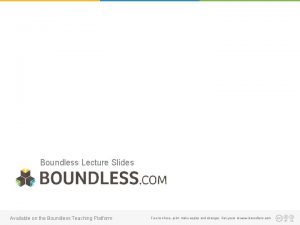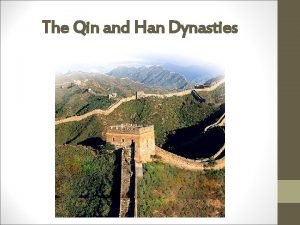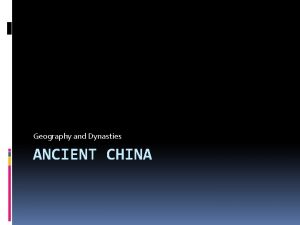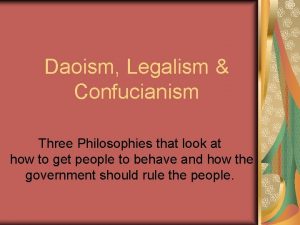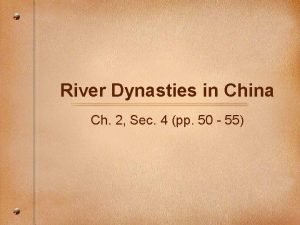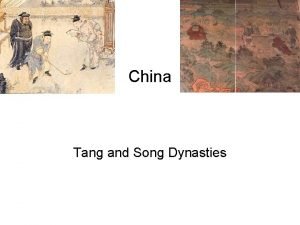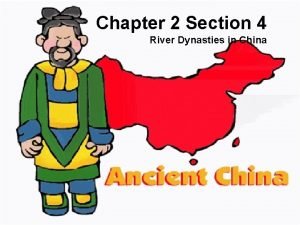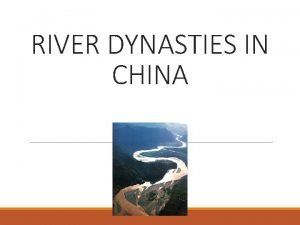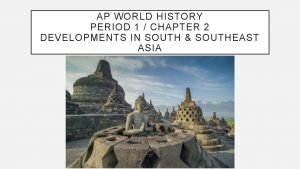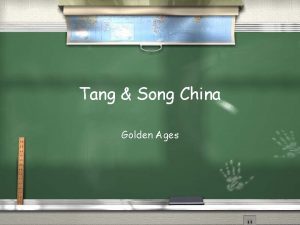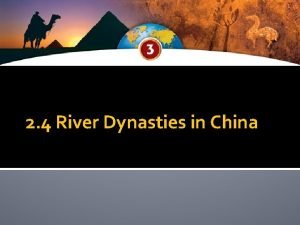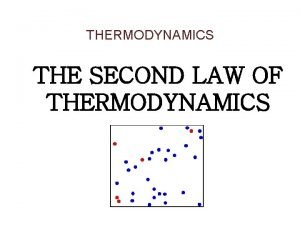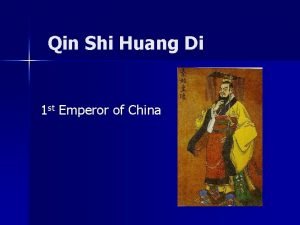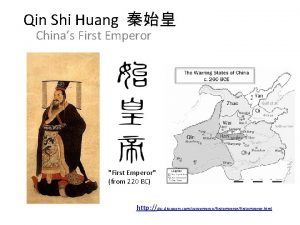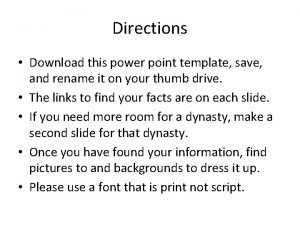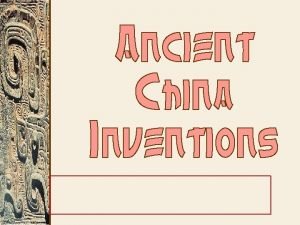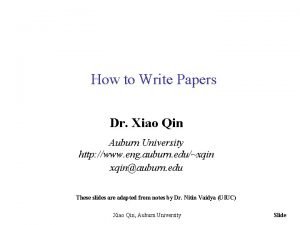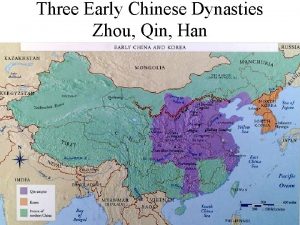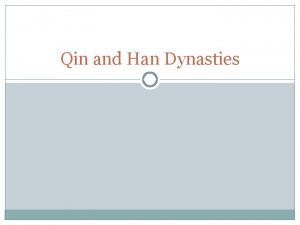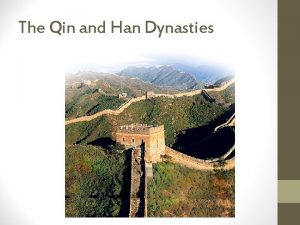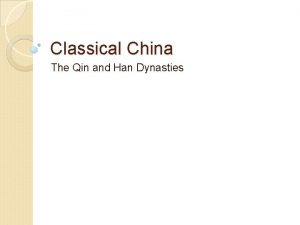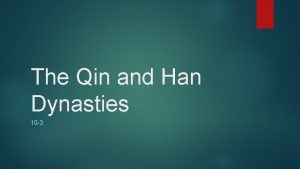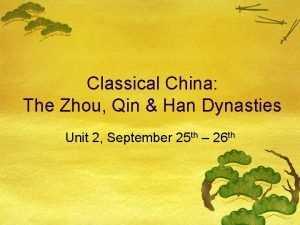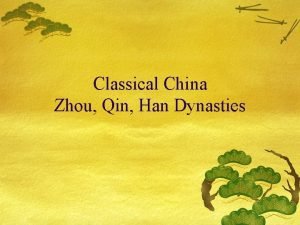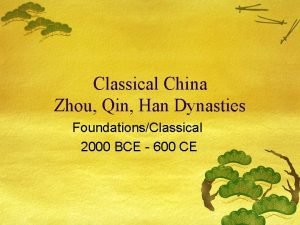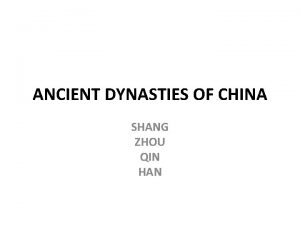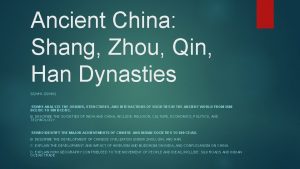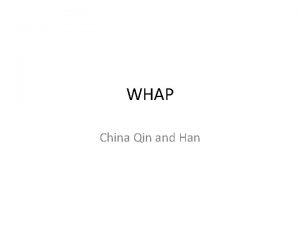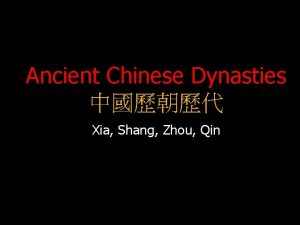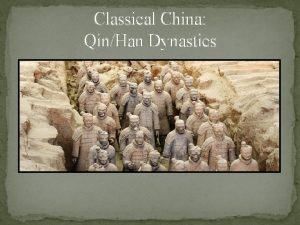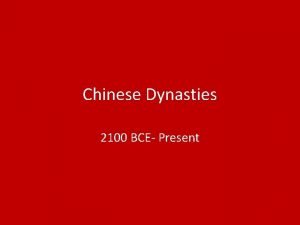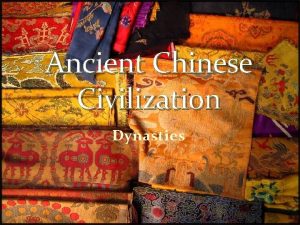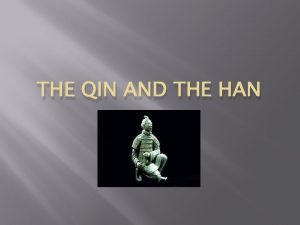Three Early Chinese Dynasties Zhou Qin Han I



































- Slides: 35

Three Early Chinese Dynasties Zhou, Qin, Han

I. The Zhou Dynasty – 1028 B. C. – 256 B. C. A. The Zhou conquered the last Shang king around 1028 B. C. 1. Zhou rulers claimed the Mandate of Heaven (heaven’s approval) 2. They established a feudal system (feudalism) a. Kings gave land to nobles in exchange for loyalty b. peasants worked land in exchange for protection

Chinese feudal system developed under the Zhou dynasty King Grants use of land to nobles in exchange for loyalty Nobles Give loyalty and armies to the king Peasants Work the land for the nobles in exchange for shelter, protection, and food Merchants Lower status than peasants because riches come from other’s work

B. Zhou technological advances 1. Major advancement = use of iron 2. cast iron = stronger weapons & farming tools; increased production 3. invented crossbow 4. invented silk cloth – becomes major trade item

C. Zhou dynasty crumbles 1. Zhou lose power & enters Era of the Warring States 2. regional kings fighting each other for land power 3. The Qin eventually win and unite China

The Warring States Period of Ancient China 480 BCE to 221 BCE

II. Two Chinese Philosophies Emerge Why do you think there was an effort to find a new governing style? Confucianism “The Analects” Teachings of Confucius “Respect yourself and others will respect you. ” Daoism Balance/Harmony with Nature

II. Two Chinese Philosophies Emerge A. Confucianism 1. Impact of Confucianism in forming the social order in China a. Belief that humans are good, not bad b. Respect for elders – Filial Piety c. Code of Politeness (still use in Chinese society today) d. Emphasis on education e. Ancestor worship http: //www. stanford. edu/group/confucian/cgi-bin/blog/? p=149 Respect link

II. Two Chinese Philosophies Emerge A. Confucianism 2. Five Primary Relationships a. ruler and subject b. father and son c. elder brother and younger brother d. husband wife e. friend and friend Respect link

II. Two Chinese Philosophies Emerge A. Confucianism 3. the Analects a. teachings of Confucius b. Provide guidelines for Confucianism Respect link


Confucianism - Filial Piety – Respect/obey elders/family - Every member of society has duty. - Role model or follower or both Writing and teachings of Confucius = Analects

II. Two Chinese Philosophies Emerge B. Daoism 1. Impact of Daoism in forming Chinese culture and values Lao Zi - founder a. Humility – low view of one’s own importance b. Simple life & inner peace c. Harmony/balance with nature Yin and Yang represent opposites for Confucianism and Taoism.

Daoism/Daoism Balance and harmony with nature Yin and Yang

III. The Qin Dynasty – 221 B. C. – 210 B. C. A. Around 221 B. C. , the Qin defeat rival kingdoms & unite much of China 1. strong centralized gov’t formed 2. military districts allowed emperor to maintain control 3. Qin Shihuangdi = 1 st emperor of China 4. China gets its name from Qin

B. Qin Shihuangdi – his achievements 1. standardized weights and measures and coinage 2. created uniform writing system 3. constructed Great Wall of China

C. The Great Wall of China 1. Invaders raided Chinese settlements from the North. 2. Qin built the Great Wall to guard against these invasions 3. Wall extended over 4, 000 miles 4. built with forced labor – many died during construction





D. Qin’s Shihuangdi’s Strict Rule 1. Imposed censorship (burned books) to control information 2. took power from local lords 3. many forced-labor projects 4. legalistic philosophy – strict laws + harsh punishments

D. The End of the Qin Dynasty 1. Qin Shihuangdi dies in 210 B. C. 2. He is buried with an army of terra cotta (clay) soldiers and horses 3. The dynasty weakens; loses control of country 4. 206 B. C. Han Dynasty comes to power

III. The Han Dynasty – 206 B. C. – A. D. 220 A. Liu Bang reunites China + becomes 1 st emperor of Han Dynasty 1. Liu Bang reestablished centralized power 2. lowered taxes and softened punishments

IV. The Han Dynasty – 206 B. C. – A. D. 220 A. Wudi – The greatest Han ruler 1. He greatly expanded the empire 2. He expanded trade routes to the west known as the Silk Roads a. Silk Roads = Series of trade routes linking China and the Mediterranean cultures & Roman Empire

3. He established the Civil Service System – system/tests for selecting most able person for gov’t jobs. 4. The Han Dynasty rivaled the Roman Empire in: a. Size Taking the Civil Service Exam b. Population c. government

Silk Roads – Connect China to Mediterranean Sea and Roman Empire

Silk Roads


Silk Roads Indian Ocean trade routes

B. Fall of the Han Dynasty 1. After Wudi died the dynasty weakened. 2. The Huns eventually overthrew the Han Dynasty

C. Other contributions of Classical China 1. invented paper 2. porcelain 3. gun powder 4. wheelbarrow

Early Chinese Crossbows Repeating Crossbow

The Terra Cotta soldiers of Shi Huangdi’s tomb

Zhou iron axe
 Chinese dynastic cycle
Chinese dynastic cycle Han sui
Han sui Qin han
Qin han Shang dynasty acrostic poem
Shang dynasty acrostic poem Chinese dynasties
Chinese dynasties Ap world history chinese dynasties
Ap world history chinese dynasties Houmuwu ding
Houmuwu ding China qin dynasty map
China qin dynasty map China dynasty
China dynasty China dynasty
China dynasty Hanfu definition
Hanfu definition Anglo chinese school chinese name
Anglo chinese school chinese name Early chinese traders who visited mindoro called our nation
Early chinese traders who visited mindoro called our nation Early cpr and early defibrillation can: *
Early cpr and early defibrillation can: * List the three chinese philosophies
List the three chinese philosophies Where was the sui dynasty located
Where was the sui dynasty located Slave khilji tughlaq lodi dynasty
Slave khilji tughlaq lodi dynasty Chapter 2 section 4 river dynasties in china
Chapter 2 section 4 river dynasties in china Ming and qing dynasty venn diagram
Ming and qing dynasty venn diagram Chapter 2 section 4 river dynasties in china
Chapter 2 section 4 river dynasties in china Which dynasty reunited china after the period of disunion?
Which dynasty reunited china after the period of disunion? River dynasties in china
River dynasties in china Sui tang song dynasties
Sui tang song dynasties Sinhala dynasties ap world
Sinhala dynasties ap world Golden age of tang and song dynasties
Golden age of tang and song dynasties Sui tang and song dynasties
Sui tang and song dynasties How did the sui and tang dynasties reunite china
How did the sui and tang dynasties reunite china The tang and song eras were a golden age of
The tang and song eras were a golden age of Achievements of the tang and song dynasties
Achievements of the tang and song dynasties River dynasties in china
River dynasties in china Wnet = qin - qout
Wnet = qin - qout Quotes about qin shi huangdi
Quotes about qin shi huangdi Qin shi huang ror
Qin shi huang ror Facts about the qin dynasty
Facts about the qin dynasty Qin dynasty inventions
Qin dynasty inventions Xiao qin auburn
Xiao qin auburn
